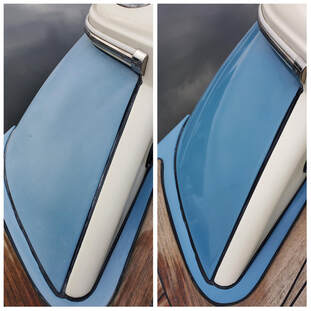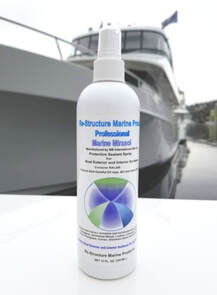MARINE APPLICATION TIPS & INSTRUCTIONS

There are three main steps you should take in order to get glossy, well-protected gel coat.
- Assess the condition of your gel coat:
- New and glossy = none or very little oxidation
- Still somewhat shiny = light oxidation
- Faded or dull = medium oxidation
- Matte finish or chalky = heavy oxidation
- Remove oxidation.
- Polish the gel coat.
Removing Oxidation
We wish there were a magic wand that could easily remove oxidation in gel coat, but unfortunately there isn't. The best way to remove boat oxidation is with compound and a variable speed buffer. Only a buffer can cut through oxidation properly and evenly. This is not something you should do by hand.
> If you have a new boat: Wash your boat first. You shouldn't need to use boat rubbing compound on new gel coat.
> If your boat has light to medium oxidation: Use a compound such as Meguiar's One-Step Compound #67 with a variable-speed buffer. We highly recommend the DeWalt 849x that you can get on Amazon.com. You can also use a dual action boat polisher (we like the Porter Cable) on smaller boats. Keep the rpm to 1800 or less so you don't burn the gel coat or paint. Do not let it dry to a haze. Simply buff it in until it disappears. We recommend doing small sections at a time, such as a two foot x two foot section, especially if working in hot temperatures or direct sunlight, so the compound doesn't dry out before you have a chance to buff it in.
> If your boat has heavy oxidation (no shine left or a matte finish): In this case, you may want to use a stronger compound meant for heavier oxidation such as 3M Perfect It #1. Don't use anything called "heavy duty" rubbing compound, "oxidation remover" or a product that has the word "restoration" in it. We've been detailing boats for 25+ years and these types of products are not only difficult to work with (even if you've been detailing boats for as long as we have), but they don't give the best results. The 3M Perfect It is easier to work with, can be found at most boating supply stores and most importantly, it uses a "diminishing effect" where it starts out with more grit, as if it were 100 grit sandpaper) and as you work it in, it diminishes into a fine grit (as if it were a 1000 grit sandpaper). Remember, the main factor that makes a boat glossy again is cutting through the layer of oxidation.
> If you have a new boat: Wash your boat first. You shouldn't need to use boat rubbing compound on new gel coat.
> If your boat has light to medium oxidation: Use a compound such as Meguiar's One-Step Compound #67 with a variable-speed buffer. We highly recommend the DeWalt 849x that you can get on Amazon.com. You can also use a dual action boat polisher (we like the Porter Cable) on smaller boats. Keep the rpm to 1800 or less so you don't burn the gel coat or paint. Do not let it dry to a haze. Simply buff it in until it disappears. We recommend doing small sections at a time, such as a two foot x two foot section, especially if working in hot temperatures or direct sunlight, so the compound doesn't dry out before you have a chance to buff it in.
> If your boat has heavy oxidation (no shine left or a matte finish): In this case, you may want to use a stronger compound meant for heavier oxidation such as 3M Perfect It #1. Don't use anything called "heavy duty" rubbing compound, "oxidation remover" or a product that has the word "restoration" in it. We've been detailing boats for 25+ years and these types of products are not only difficult to work with (even if you've been detailing boats for as long as we have), but they don't give the best results. The 3M Perfect It is easier to work with, can be found at most boating supply stores and most importantly, it uses a "diminishing effect" where it starts out with more grit, as if it were 100 grit sandpaper) and as you work it in, it diminishes into a fine grit (as if it were a 1000 grit sandpaper). Remember, the main factor that makes a boat glossy again is cutting through the layer of oxidation.
Applying Our Detailing Polishes
After you have compounded the gel coat or paint to remove oxidation and the boat is glossy again (which is how you'll know if you've removed the oxidation), you’ll have a significant amount of compound dust on your boat. You must wash your boat to remove any compounding dust so you can apply the polish to a clean surface. This will help the polish seal your gel coat or paint, which is what makes it last so long.
Apply a thin amount of polish, by hand or with a polisher until the high-gloss shine appears. Do not let the polish dry to a haze. Ideally, you should only apply polish on a cool, dry surface, preferably in the shade.
What's the best applicator to apply the polish with? A foam pad works very well with our polishes. A little bit goes a long way so start with a quarter size amount of polish on the pad and as it gets saturated with the polish, you'll be able to use less for each section.
Most waxes and polishes state “use liberally” right on the label. You or your detailer have probably used lots of products that you wipe on, let dry and then work hard to buff off. In fact, this process literally creates yet another step, cleaning up the white residue left everywhere, including in the water, on the dock and on your canvas. Our polish doesn’t leave that white residue or dust everywhere, making clean up much faster and easier.
With our One-Step Detailing Polish or Pure Polish,
Re-Application Instructions
It's best to re-apply our polish each season to maintain its protection and help prevent oxidation. Before applying another coat of polish, look for areas that may need touch-ups with a finishing compound. This would include any areas that have scuff marks in the gel coat or from shore power cords or where there's been fiberglass repair work done. Simply use the finishing compound by hand to remove any stains, marks or imperfections in the finish.
Wash the boat and dry it well or let it dry on its own. Re-apply another thin coat of polish by hand or with a polisher.
OTHER USES FOR OUR ONE-STEP DETAILING POLISH or CLEANING POLISH:
In addition to removing light oxidation, use it to:
OTHER USES FOR OUR PURE POLISH:
In addition to protecting gel coat and painted surfaces, use the pure polish to:
Apply a thin amount of polish, by hand or with a polisher until the high-gloss shine appears. Do not let the polish dry to a haze. Ideally, you should only apply polish on a cool, dry surface, preferably in the shade.
What's the best applicator to apply the polish with? A foam pad works very well with our polishes. A little bit goes a long way so start with a quarter size amount of polish on the pad and as it gets saturated with the polish, you'll be able to use less for each section.
Most waxes and polishes state “use liberally” right on the label. You or your detailer have probably used lots of products that you wipe on, let dry and then work hard to buff off. In fact, this process literally creates yet another step, cleaning up the white residue left everywhere, including in the water, on the dock and on your canvas. Our polish doesn’t leave that white residue or dust everywhere, making clean up much faster and easier.
With our One-Step Detailing Polish or Pure Polish,
- It's easy to rub in and wipe off.
- It leaves no white residue on black trim or canvas.
- A little bit goes a long way - one drop on your palm will cover 1 square foot.
- Nothing gets washed off into the water, so it's completely environmentally friendly.
- No more breathing harmful wax dust while polishing your boat.
- Your microfiber rags can easily be washed and used again since they won't have any wax in them and therefore won't ruin the washing machine. (Never use fabric sheets when drying your rags in the drying machine or they'll lose their absorbency.)
Re-Application Instructions
It's best to re-apply our polish each season to maintain its protection and help prevent oxidation. Before applying another coat of polish, look for areas that may need touch-ups with a finishing compound. This would include any areas that have scuff marks in the gel coat or from shore power cords or where there's been fiberglass repair work done. Simply use the finishing compound by hand to remove any stains, marks or imperfections in the finish.
Wash the boat and dry it well or let it dry on its own. Re-apply another thin coat of polish by hand or with a polisher.
OTHER USES FOR OUR ONE-STEP DETAILING POLISH or CLEANING POLISH:
In addition to removing light oxidation, use it to:
- Remove scuff marks left from shoes or shore power cords
- Remove bird and spider droppings
- Remove rust from stainless and other metal objects
- Clean rubber, aluminum or metal rub rails and trim
- Remove light scratches and swirl marks from plastic windows
- Clean metal sinks with to remove water spots and rust
- Remove light water spots from glass windows
OTHER USES FOR OUR PURE POLISH:
In addition to protecting gel coat and painted surfaces, use the pure polish to:
- Seal your glass windshield to protect from water spots and salt spray
- Protect stainless rails, cleats and trim from salt spray and rust and to keep them shiny
- Clean and protect interior surfaces such as sinks, counters, windows and shower doors from water spots and to make future clean-up easier
Using Mirasol Multi-Surface Protectant

Use Mirasol as a way to help the polish last longer. Use it as a spray and wipe cleaner on all gel coat and painted surfaces in between boat washes. Use it for quick touch ups around your boat. It’s meant for all surfaces, including stainless, plastic windows, gel coat, painted surfaces, granite countertops, glass or acrylic shower doors, ceramic and more.
Apply to a clean surface using a soft cloth in a brisk, circular motion until a high gloss shine appears. At this point, the nano-particles have bonded with the surface, filling in pores and scratches and leaving a glass-like finish and shine. One application of Mirasol Multi-Surface Protectant Spray will last for several months
Apply to a clean surface using a soft cloth in a brisk, circular motion until a high gloss shine appears. At this point, the nano-particles have bonded with the surface, filling in pores and scratches and leaving a glass-like finish and shine. One application of Mirasol Multi-Surface Protectant Spray will last for several months

